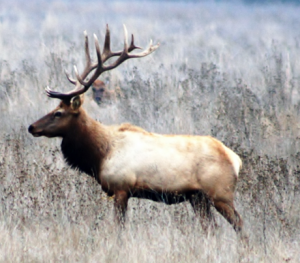 Source: Center for Biological Diversity
Source: Center for Biological Diversity
August 8, 2019 (Point Reyes, Calif.) -- The National Park Service released a draft plan today that calls for shooting native elk to allow for expanded cattle ranching and commercial agriculture at Point Reyes National Seashore. The plan would allow the killing of tule elk, damage to wildlife habitat, harm of endangered species, degradation of water quality and create new conflicts with other native wildlife species.
The Park Service’s proposed alternative for an amendment to the park’s General Management Plan would enshrine cattle grazing as the primary use of a huge swath of the National Seashore, at the expense of native wildlife and natural habitats. (You can submit public comments by clicking the “proposed alternative” link.)
“This is a shockingly anti-wildlife plan, and killing these elk will do nothing to fix or reduce the environmental damage caused by cattle ranching,” said Jeff Miller, senior conservation advocate at the Center for Biological Diversity. “What is the Park Service thinking? Allowing expansion of commercial agricultural activities would inevitably lead to further conflicts with other native wildlife. After the elk shooting starts, get ready for ranchers to call for the slaughter of the park’s bobcats, foxes and birds.”
The Park Service proposes to kill native tule elk and haze them off 18,000 acres of the park to allow private ranchers’ cattle sole access to these public lands. Under this plan, enough tule elk would be killed to establish an arbitrary 120-member population threshold for the Drakes Beach herd.
This free-roaming herd currently has 124 elk and has been slowly expanding. This is the only National Park where tule elk occur.
The plan would also allow conversion of park grasslands and wildlife habitat at Point Reyes to artichoke farms and other row crops, as well as the expansion of commercial livestock farming to introduce sheep, goats, pigs or chickens. This would inevitably lead to conflicts with other native wildlife in the park and could result in ranchers calling for killing of coyotes, bobcats, foxes and numerous birds.
The plan would extend 20-year lease terms to 15 private dairy and beef ranches in the park, on approximately 26,100 acres. The plan would expand ranching leases into an additional 7,600 acres of the park that are currently not authorized for cattle ranching.
The plan includes vague aspirational management guidelines to protect natural resources from damage from cattle grazing and ranching. But the Park Service has been unable and unwilling to enforce many of the current grazing lease conditions. The plan would authorize excessive levels of cattle stocking that have led to overgrazing, resulting in significant soil erosion, degradation of water quality, damage to endangered species habitat and the spread of invasive plants in the park.
In 2016 the Resource Renewal Institute, Center for Biological Diversity and Western Watersheds Project filed a federal lawsuit against the National Park Service for failing to update the park’s badly outdated general management plan before attempting to extend cattle grazing leases in the Point Reyes National Seashore.
In 2017 conservationists, ranchers and the Park Service agreed on a four-year plan to address cattle ranching and tule elk conflicts at Point Reyes through a public environmental review process and an amendment to the national seashore’s management plan.
The reintroduction of tule elk to the Point Reyes peninsula has so far been a success story for the conservation of native species and restoring ecosystems, in keeping with the mission of the National Park Service.
The Drakes Beach elk herd is one of two free-roaming herds in the park. Letting elk roam free is critical to their survival. More than half the elk in the Tomales Point herd, which is fenced in on a peninsula to appease ranchers, died during a recent drought because of a lack of water and food.







Comments
Sad day for our National Park
Beef
It's always about money.. Follow the money. Eat less beef.
Eat less beef